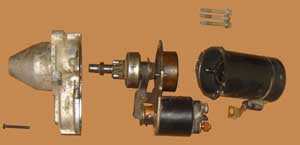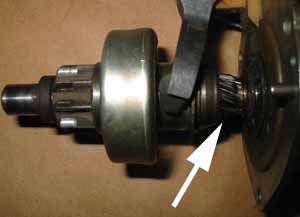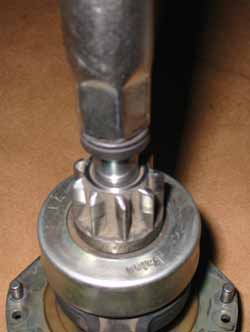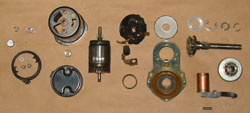Valeo starter overhaul
This page is being overhauled, and will show the weaknesses in the Valeo starters and the fixes for them.
Valeo D6RA starters were used in production starting with the 1988 R100GS, and starting in 1989 all of the boxer models had them. They are much lighter than the Bosch starters and draw less current. The Valeo became the replacement part for all Aiheads, with a different model introduced to replace the early 8-tooth Bosch starters. Here are the models involved:
- Airheads through 1974: D6RA94 12 41 1 357 500
- Airheads 1975-on: D6RA7 -> D66RA15, 12 41 9 062 425
- Oilheads: D6RA55 -> D6RA75 12 41 2 306 700
However, they are not trouble-free. Three common issues are:
1) The internals simply dry out and crud up. The nose bushing gets worn, the lubrication at the bendix and at the rear armature bushing dries up and becomes sticky, the solenoid plunger gets dirty, the planetary gear lube dries up, etc.You need to disasemble, clean and grease the whole unit.
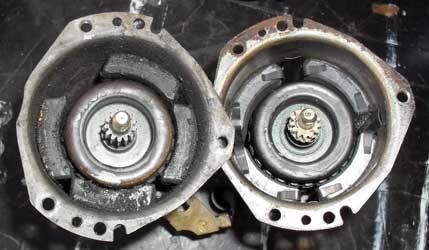
2) The permanent magnets in the magnet housing (the outer starter motor housing) detach from the wall, move around, and jam the armature. This problem can happen on any of the Airhead or Oihead starters up to 2002. At that point the model numbers changed (D6RA7 became D6RA15, D6RA55 became D6RA75) and the magnets were held in place by clips and possibly a better adhesive. This cured the problem, but fifteen years' worth of motorcycles were out there with starters that did not have this improvement. New replacement Valeo starters, and new magnet housings, have the fix. You need to replace the starter or the magnet housing.
3) The shield for the planetary gears can be dislodged and will then short out the armature. The shield can be repositioned but the armature may be damaged. Some armatures have a cap over the end of the armature but the one pictured doesn't. You may be able to repair this without replacing any parts, but the armature may be damaged by excess current draw.
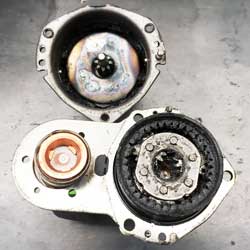
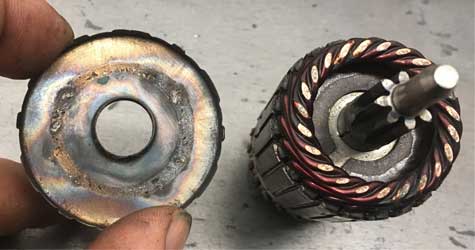
Old content below:
======================
If your Valeo starter makes a screeching run-on noise after starting the engine, it needs to be cleaned and greased. Other symptoms of starter trouble vary, but inevitably the starter needs to be pulled apart for cleaning and inspection. If your starter has an electrical fault (not working, intermittent operation, etc), read Greg's article linked at the bottom of the page. If your starter has loosened magnets, read Alex's article or just buy a new magnet housing. Contrary to what I've read on the web, I don't think the squealing problem is caused by the planetary gears as much as by the solenoid mechanism (plunger and pinion splines).
For reference, here are the internal parts, names used, and replacement availablity from BMW for the D6RA15 starter used on Airheads. BMW does not list any repair parts for the D6RA55/D6RA75 starter used on the Oilheads, but the brush sets and repair kit #4 will work. Differences are listed at the bottom of this page. At the time of writing this, replacement pinions, brushes, solenoids, etc. were available from BMW. Pinions and solenoids were about $120, and brushes were $10 to $20 depending on which kit you need.
 |
1. Solenoid switch, 12 41 1 244 607
2.Clutch fork lever, 12 41 1 244 609 3. Starter pinion, 12 41 1 244 682 4. Repair kit, 12 41 1 244 611 5. Carbon brush set, 12 41 1 244 684 6. Spring washer, 12 41 1 244 623 7. Hex nut, 12 41 1 244 622 8. Repair kit screws, 12 41 1 244 613 9. Carbon brush set, 12 41 1 244 685 |
Tools needed:
- Torx T25 or 4mm allen for removing the three motor housing bolts
- Torx T20 for removing the solenoid switch
- 13mm wrench for removing the solenoid lead
- 8mm wrench for removing the brush assembly
Basic disassembly process
Disassembling the starter shaft
Differences between D6RA7/15 and D6RA55
Although the starters are very similar in construction, they turn in different directions and have different reduction gears. So, basically all of the main parts (magnet housing, commutator, bendix, planetaries, nose casting) are different. However, the main tune-up parts (brush holder, brushes, nose bushings) are the same. Euromotoelectrics sells them as a kit.
Replacement
The D6RA15 may also be known as 432586.
One source is Ace Houston Warehouse. Contact Bob Spencer, 800-392-3332 acehoutx@flash.net and be sure to quote the Airheads Club account #700 to get the discount.
Parts not available from the dealer might be available from Euro Moto Electrics in Colorado. Euro Moto carries new magnet housings, which are not available from BMW.
Other Valeo Starter repair links that I referred to for this:
Greg Feneis' article on the Airheads site (no longer publicly available) concentrates on electrical problems
Joerg Hau's R80GS page concentrates on the swapping magnet housings
On Alex's page look under "Technical Stuff" and there are some photo galleries showing these starters and their problems.
